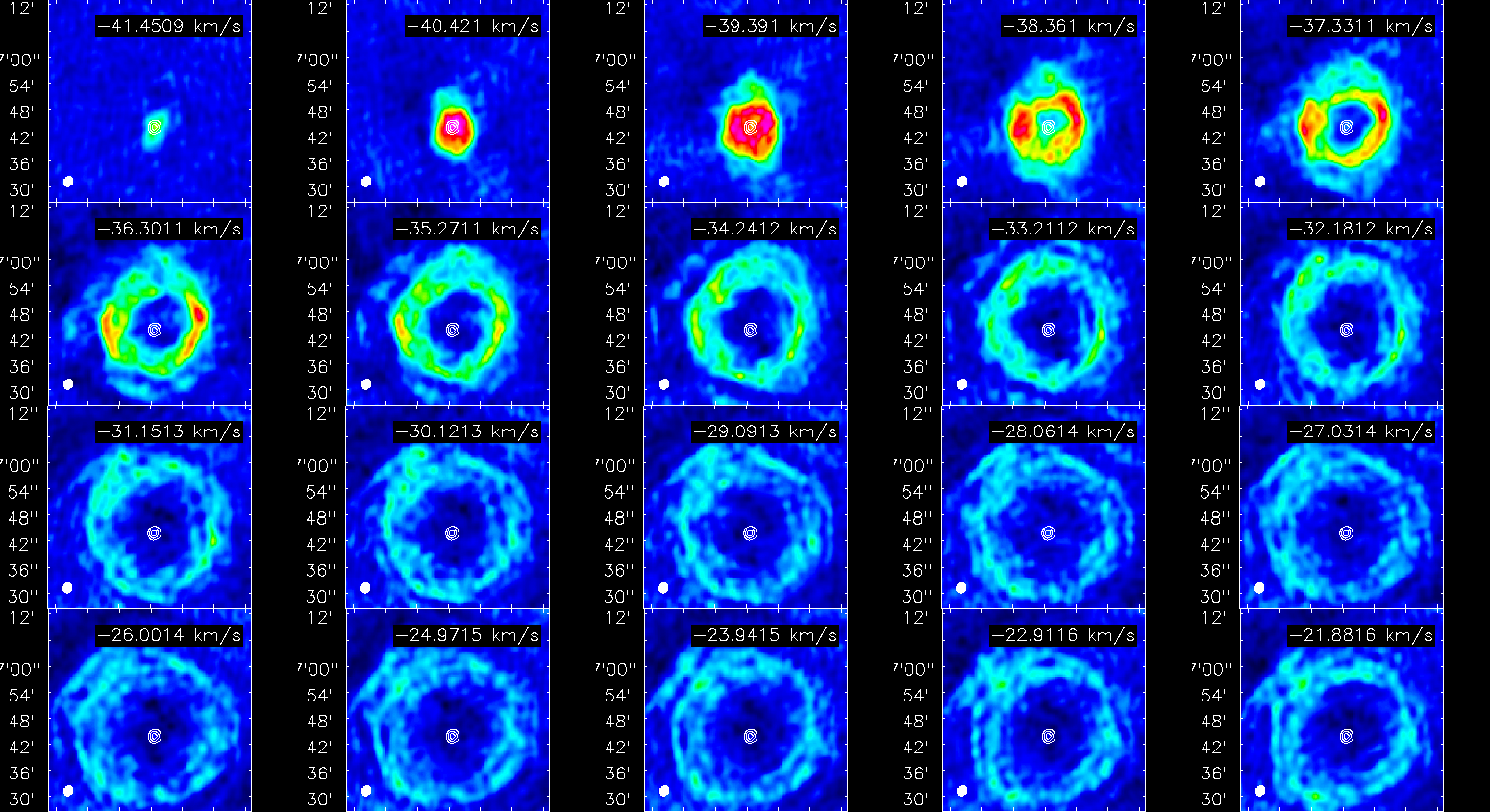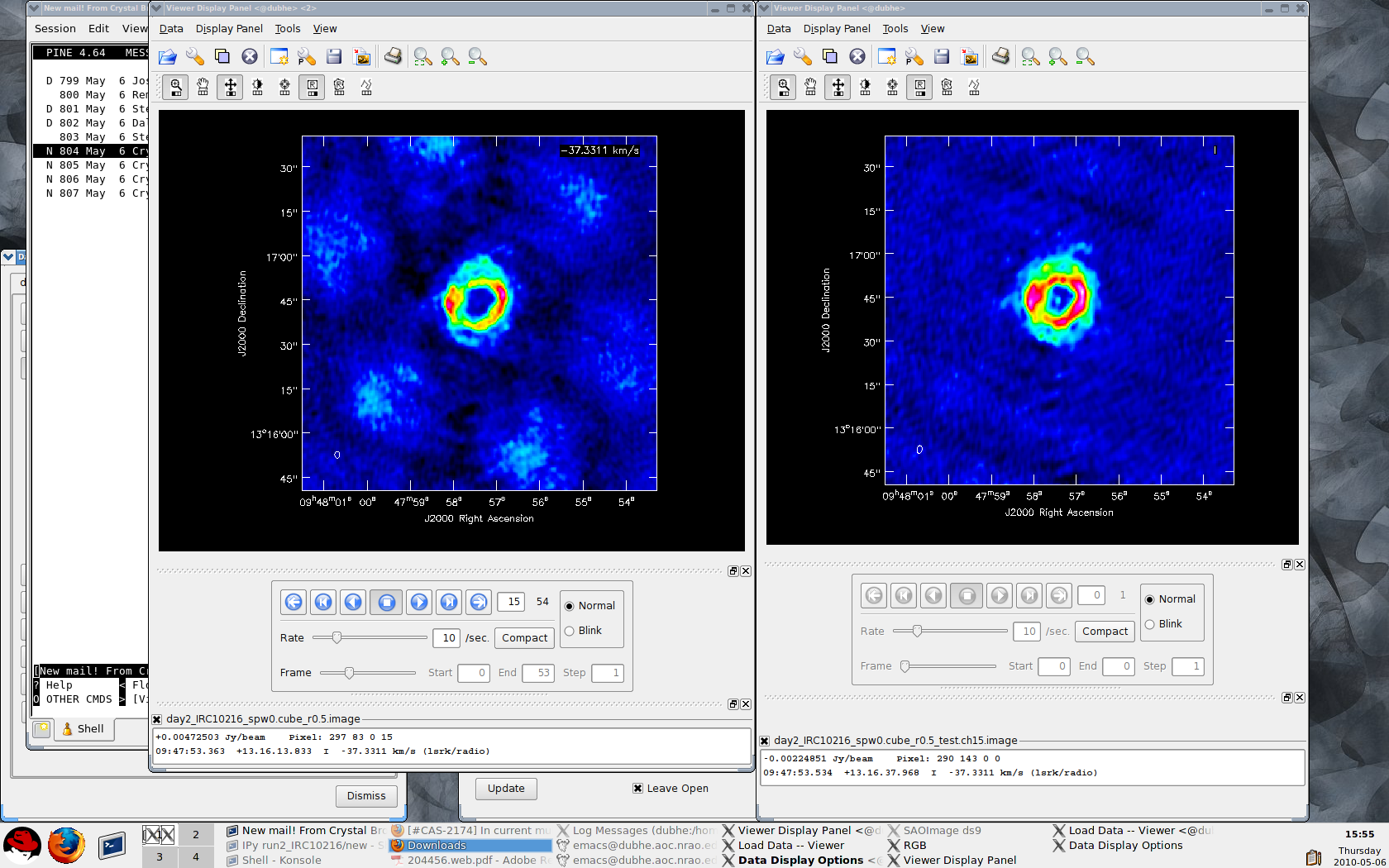EVLA spectral line IRC10216: Difference between revisions
| Line 712: | Line 712: | ||
==Deconvolve and Clean== | ==Deconvolve and Clean== | ||
Here we make images from the calibrated data. Because the spectral line emission from IRC+10216 has significant extended emission, it is very important to run clean interactively, and make a clean mask. In this example, when the viewer first pops up with the dirty image, we step through to the channel with the most extended (in angular size) emission, select "all channels" for the clean mask, select the polygon tool and make a single mask that applies to all channels. After making the mask you should check that the emission in all the other channels fits within the mask you made. If you had the time and patience you could make a clean mask for each channel -- this would create a slightly better result. Keep cleaning until the residual displayed in the view looks "noise like". You will notice that in this particular case, there are residuals that cannot be cleaned -- these are due to the extended resolved out structure. | Here we make images from the calibrated data. Because the spectral line emission from IRC+10216 has significant extended emission, it is very important to run clean interactively, and make a clean mask. In this example, when the viewer first pops up with the dirty image, we step through to the channel with the most extended (in angular size) emission, select "all channels" for the clean mask, select the polygon tool and make a single mask that applies to all channels. After making the mask you should check that the emission in all the other channels fits within the mask you made. If you had the time and patience you could make a clean mask for each channel -- this would create a slightly better result. | ||
Keep cleaning until the residual displayed in the view looks "noise like". You will notice that in this particular case, there are residuals that cannot be cleaned -- these are due to the extended resolved out structure on size scales larger than the array is sensitive to (i.e. "Largest Angular Scale" or LAS the array is sensitive to can be calculated from the shortest baseline length). Later in the tutorial we describe how to do a better job with extended sources. | |||
[[Image:viewer_interactive.png|thumb|Interactive viewer with polygon tool, "All channels" selected" and mask drawn on channel 28.]] | [[Image:viewer_interactive.png|thumb|Interactive viewer with polygon tool, "All channels" selected" and mask drawn on channel 28.]] | ||
Revision as of 22:06, 9 May 2010
This tutorial is under construction. There are several things still to be added in addition to overall polish and further annotation: * screen captures of task inputs * uvcontsub and continuum imaging * moment maps * more about cleaning in general * multiscale clean
Overview
This tutorial describes the data reduction for two spectral lines observed toward the AGB star IRC+10216. This Carbon star which is a few times more massive than our sun is nearing the end of its life, and is thought to be in the process of forming a planetary nebula.
In this EVLA OSRO1 mode observation one subband was observed in each of two basebands, the subbands were centered on the HC3N and SiS lines near 36 GHz. The raw data were loaded into CASA with importevla, where zero and shadowed data were flagged. Then the data were "split", so we could average from the native 1 second integrations to 10 seconds, select only antennas with Ka-band receivers, and select only spws with Ka-band data. This produces a significantly smaller dataset for processing.
The post-split averaged data can be downloaded from http://casa.nrao.edu/Data/EVLA/IRC10216/day2_TDEM0003_10s_norx.tar
Information from observing log: There are no Ka-band receivers on ea11, ea13, ea14, ea16, ea17, ea18, ea26 Antennas ea10, ea06 are out of the array Antenna ea12 is newly back The pointing is often bad on ea15 Antennas ea10, ea12, ea22 do not have good baseline positions
Initial Inspection and Flagging
# In CASA
listobs(vis='day2_TDEM0003_10s_norx')
Below we have cut and pasted the most relevant output from the logger.
Fields: 4 ID Code Name RA Decl Epoch SrcId nVis 2 D J0954+1743 09:54:56.8236 +17.43.31.2224 J2000 2 65326 3 NONE IRC+10216 09:47:57.3820 +13.16.40.6600 J2000 3 208242 5 F J1229+0203 12:29:06.6997 +02.03.08.5982 J2000 5 10836 7 E J1331+3030 13:31:08.2880 +30.30.32.9589 J2000 7 5814 (nVis = Total number of time/baseline visibilities per field) Spectral Windows: (2 unique spectral windows and 1 unique polarization setups) SpwID #Chans Frame Ch1(MHz) ChanWid(kHz)TotBW(kHz) Ref(MHz) Corrs 0 64 TOPO 36387.2295 125 8000 36387.2295 RR RL LR LL 1 64 TOPO 36304.542 125 8000 36304.542 RR RL LR LL Sources: 10 ID Name SpwId RestFreq(MHz) SysVel(km/s) 0 J1008+0730 0 0.03639232 -0.026 0 J1008+0730 1 0.03639232 -0.026 2 J0954+1743 0 0.03639232 -0.026 2 J0954+1743 1 0.03639232 -0.026 3 IRC+10216 0 0.03639232 -0.026 3 IRC+10216 1 0.03639232 -0.026 5 J1229+0203 0 0.03639232 -0.026 5 J1229+0203 1 0.03639232 -0.026 7 J1331+3030 0 0.03639232 -0.026 7 J1331+3030 1 0.03639232 -0.026 Antennas: 19: ID Name Station Diam. Long. Lat. 0 ea01 W09 25.0 m -107.37.25.2 +33.53.51.0 1 ea02 E02 25.0 m -107.37.04.4 +33.54.01.1 2 ea03 E09 25.0 m -107.36.45.1 +33.53.53.6 3 ea04 W01 25.0 m -107.37.05.9 +33.54.00.5 4 ea05 W08 25.0 m -107.37.21.6 +33.53.53.0 5 ea07 N06 25.0 m -107.37.06.9 +33.54.10.3 6 ea08 N01 25.0 m -107.37.06.0 +33.54.01.8 7 ea09 E06 25.0 m -107.36.55.6 +33.53.57.7 8 ea12 E08 25.0 m -107.36.48.9 +33.53.55.1 9 ea15 W06 25.0 m -107.37.15.6 +33.53.56.4 10 ea19 W04 25.0 m -107.37.10.8 +33.53.59.1 11 ea20 N05 25.0 m -107.37.06.7 +33.54.08.0 12 ea21 E01 25.0 m -107.37.05.7 +33.53.59.2 13 ea22 N04 25.0 m -107.37.06.5 +33.54.06.1 14 ea23 E07 25.0 m -107.36.52.4 +33.53.56.5 15 ea24 W05 25.0 m -107.37.13.0 +33.53.57.8 16 ea25 N02 25.0 m -107.37.06.2 +33.54.03.5 17 ea27 E03 25.0 m -107.37.02.8 +33.54.00.5 18 ea28 N08 25.0 m -107.37.07.5 +33.54.15.8
Summary of Observing Strategy Gain Calibrator: J0954+1743 field id=2 Bandpass Calibrator: J1229+0203 field id=5 Flux Calibrator: J1331+3030 (3C286) field id=7 Target: IRC+10216 field id=3 Ka-band spws = 0,1
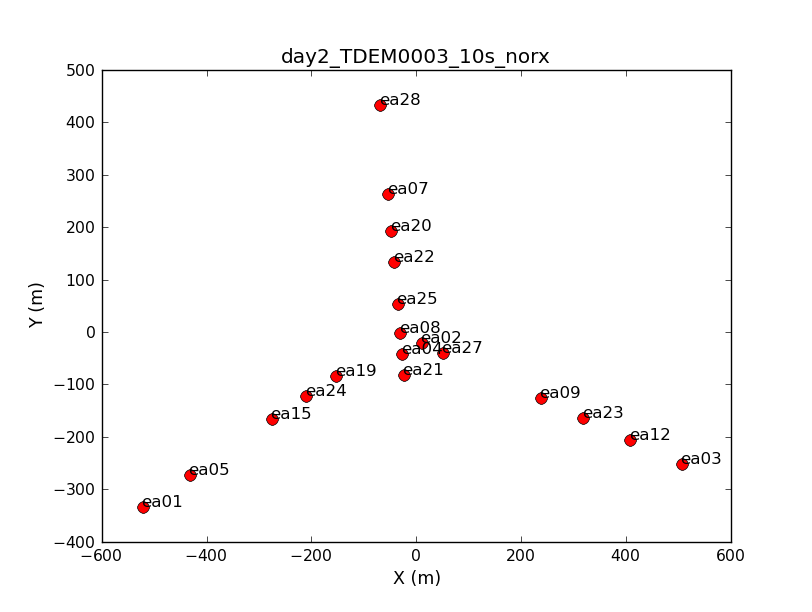
Look at a graphical plot of the antenna locations and save hardcopy in case you want it later. This will be useful for picking a reference antenna -- typically a good choice is an antenna close to the center of the array. Unless it shows problems after inspection of the data, we provisionally chose ea02.

# In CASA
plotants(vis='day2_TDEM0003_10s_norx',figfile='ant_locations.png')
Next lets look at the elevation as a function of time for all sources. Its not the case for this data, but if the elevation is very low (usually at start or end of track, you may want to flag). Also, how near in elevation your flux calibrator is to your target will impact your ultimate absolute flux calibration accuracy. Unfortunately, they are not particularly well match for this observation. Something to keep in mind when planning observations. Thus we are strongly dependent on the opacity and gaincurve corrections to get the flux scale right for these data.
# In CASA
plotms(vis='day2_TDEM0003_10s_norx',
xaxis='time',yaxis='elevation',correlation='RR,LL',
avgchannel='64',spw='0:4~60')
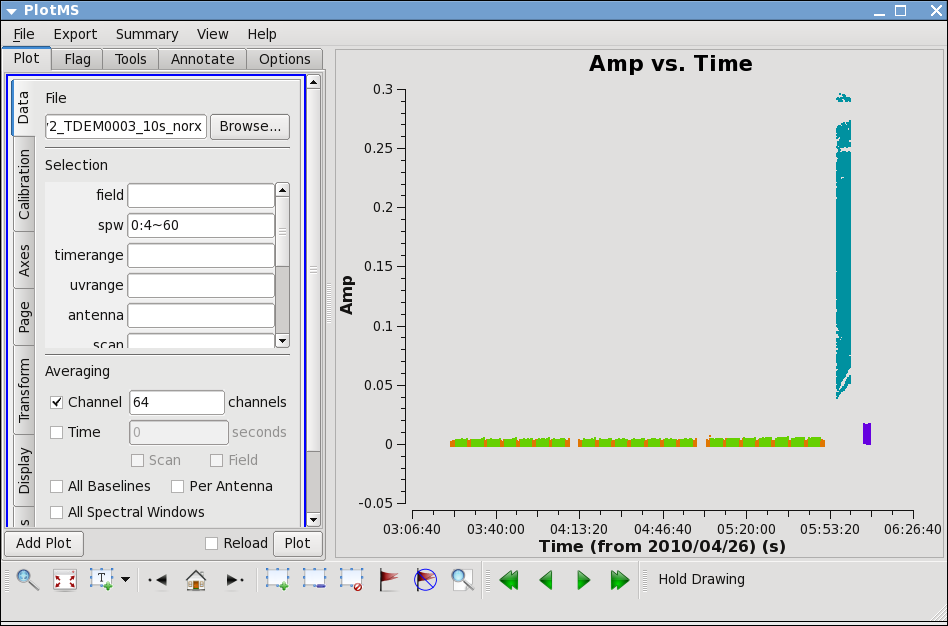
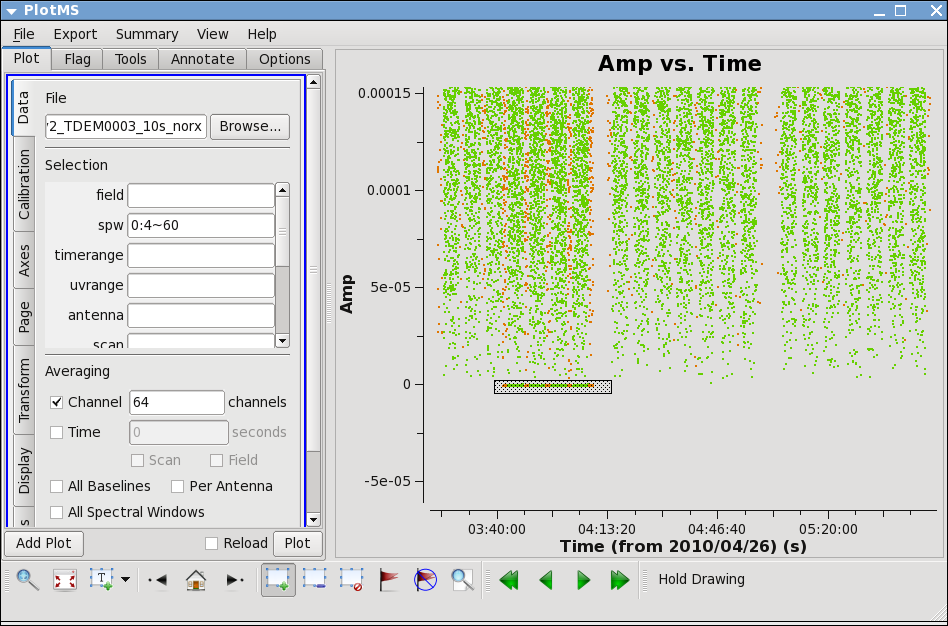
Next lets look at all the source amplitudes as a function of time.
# In CASA
plotms(vis='day2_TDEM0003_10s_norx',
xaxis='time',yaxis='amp',correlation='RR,LL',
avgchannel='64',spw='0:4~60')
Select the "Display" tab and colorize by field.
Now zoom in on the region near zero for sources J0954+1743 and IRC+10216 Look for the low values. Use the Mark and Locate buttons to see which antenna it is: ea12 Now zoom further to see the time range: 03:41:00~04:10:00
Check the other sideband by changing spw to 1:4~60. You will have to rezoom. If you have trouble click on Mark icon and then back to zoom. In spw=1, ea07 is bad from the beginning until after next pointing run: 03:21:40~04:10:00
In the plotms gui, put !ea07 in the antenna parameter, this removes ea07 from the plot (in CASA selection, ! deselects) allowing you to see that ea12 is also bad during the same time range as for spw 0
We can set up a flagging command to get both bad antennas for the appropriate time/spw
# In CASA
flagdata(vis='day2_TDEM0003_10s_norx',
field=['2,3','2,3'],
spw=['','1'],
antenna=['ea12','ea07'],
timerange=['03:41:00~04:10:00','03:21:40~04:10:00'])
Note because timerange is set, the field parameter is not really needed here -- the time range is limited to these fields, but flagdata will run fastest if you put as many constraints as possible.
Now remove the !ea07 from antenna and replot both spw, zooming in to be sure that all obviously low points are gone. Also zoom in and check 3C286, J1229+0203 is already obvious because it is so bright.
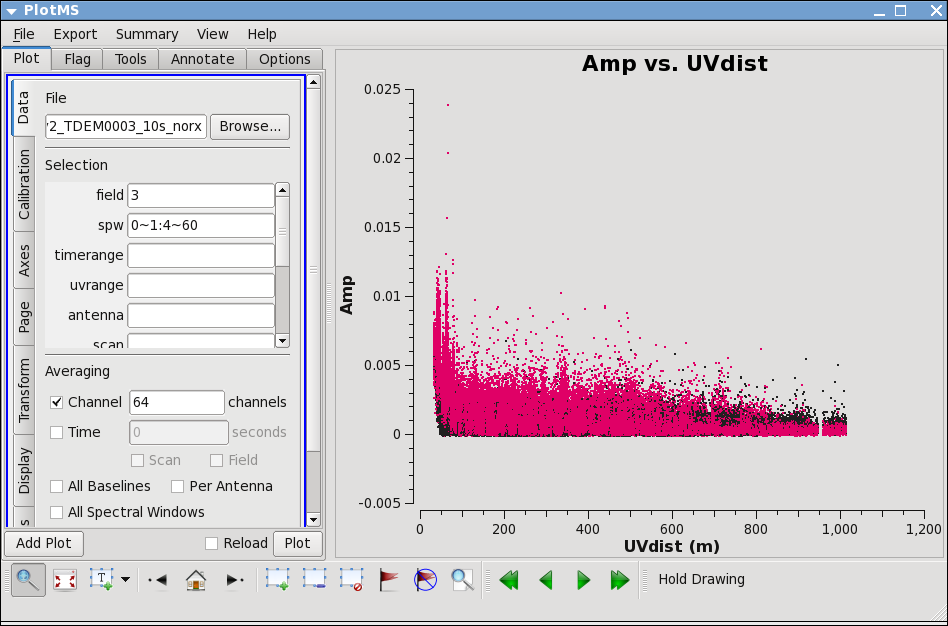
Lets look more closely at IRC+10216
# In CASA
plotms(vis='day2_TDEM0003_10s_norx',field='3',
xaxis='time',yaxis='amp',correlation='RR,LL',
avgchannel='64',spw='0~1:4~60')
Go to the "display" tab and chose colorize by spw. You can see a that there are some noisy high points. But now try
# In CASA
plotms(vis='day2_TDEM0003_10s_norx',field='3',
xaxis='uvdist',yaxis='amp',correlation='RR,LL',
avgchannel='64',spw='0~1:4~60')
Most of the high points on IRC+10216 are due to large scale emission on short baselines, but there is still some noisy stuff -- for a target like this with extended emission its best to wait until later to decide what to do about it. We will not be able to get adequate calibration for antennas that are truly bad (even if they don't stand out here) so these will be obvious later.
Set the Flux Calibrator
# In CASA
setjy(vis='day2_TDEM0003_10s_norx',field='7',spw='0',
modimage='/usr/lib64/casapy/data/nrao/VLA/CalModels/3C286_K.im')
# In CASA
setjy(vis='day2_TDEM0003_10s_norx',field='7',spw='1',
modimage='/usr/lib64/casapy/data/nrao/VLA/CalModels/3C286_K.im')
The logger output for spw=0 is: setjy J1331+3030 spwid= 0 [I=1.692, Q=0, U=0, V=0] Jy, (Perley-Taylor 99) setjy Using model image /usr/lib64/casapy/data/nrao/VLA/CalModels/3C286_K.im setjy The model image's reference pixel is 0.00188929 arcsec from J1331+3030's phase center. setjy Scaling model image to I=1.69182 Jy for visibility prediction.
The modimage location is appropriate for running CASA at the AOC. If you are running elsewhere (laptop or Mac), in a terminal type locate 3C286_K.im to find where the models live (the models are always shipped with CASA).
Bandpass
Before doing the bandpass we need to inspect phase and amplitude variations with time and frequency on the bandpass calibrator to decide how best to proceed. We limit the number of antennas to make the plot easier to see. We chose ea02 as it seems like a good candidate for the reference antenna.
# In CASA
plotms(vis='day2_TDEM0003_10s_norx',field='5',
xaxis='channel',yaxis='phase',correlation='RR',
avgtime='1e8',spw='0:4~60',antenna='ea02&ea23')
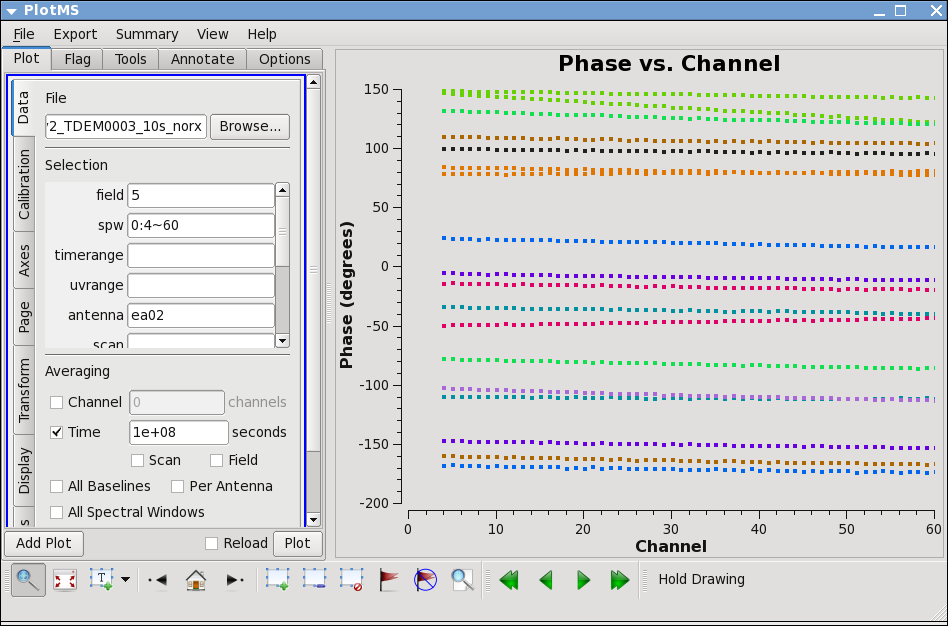
The phase variation is modest ~10 degrees. Now expand to all antennas with ea02 and select colorize by Antenna2.
# In CASA
plotms(vis='day2_TDEM0003_10s_norx',field='5',
xaxis='channel',yaxis='phase',correlation='RR',
avgtime='1e8',spw='0:4~60',antenna='ea02')
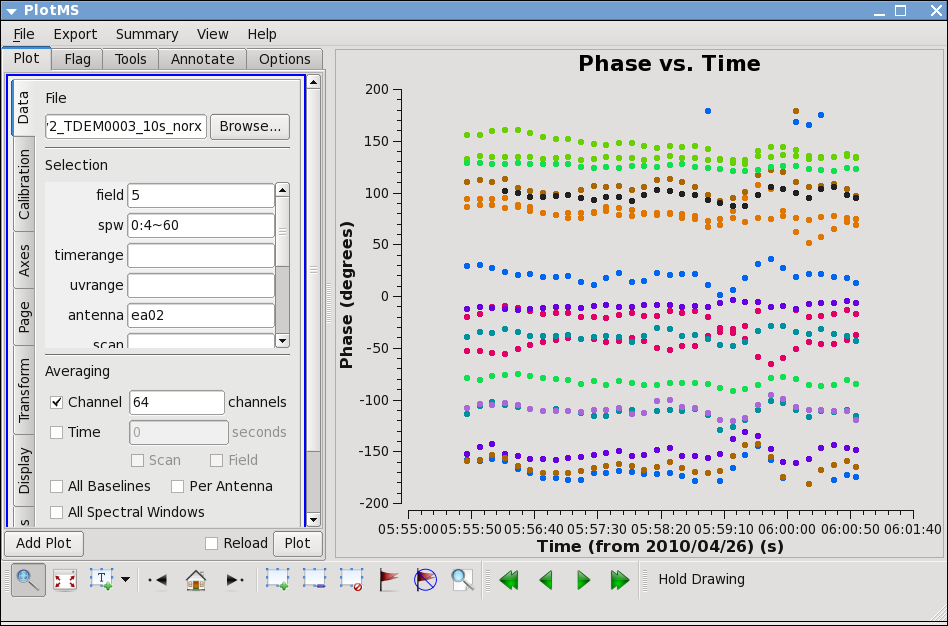
Go to the "display" tab and chose colorize by antenna2. From this you can see that the phase variation across the bandpass is modest. Next check LL, and spw=1, both correlations. Also check other antennas if you like.
Now look at the phase as a function of time.
# In CASA
plotms(vis='day2_TDEM0003_10s_norx',field='5',
xaxis='time',yaxis='phase',correlation='RR',
avgchannel='64',spw='0:4~60',antenna='ea02&ea23')
Expand to all antennas with ea02
# In CASA
plotms(vis='day2_TDEM0003_10s_norx',field='5',
xaxis='time',yaxis='phase',correlation='RR',
avgchannel='64',spw='0:4~60',antenna='ea02')
You can see that the phase variations are smooth, but do vary significantly over the 5 minutes of observation -- in most cases by a few 10s of degrees. Zoom in to see this better if you want.
The conclusion from this investigation is that you need to correct the phase variations with time before solving for the bandpass to prevent decorrelation of the vector averaged bandpass solution. Since the phase variation as a function of channel is modest, you can average over several channels to increase the signal to noise of the phase vs. time solution. If the phase variation as a function of channel is larger you may need to use only a few channels to delay-based closure errors from averaging over non-bandpass corrected channels.
Since the bandpass calibrator is quite strong we do the phase-only
solution on the integration time of 10 seconds (solint='int').
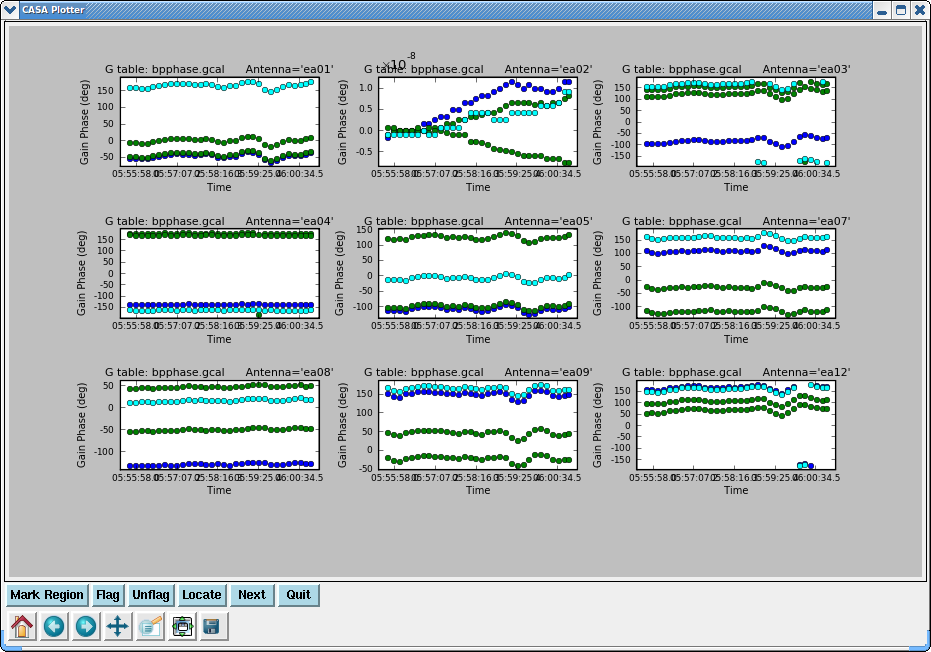
# In CASA
gaincal(vis='day2_TDEM0003_10s_norx',caltable='bpphase.gcal',
field='5',spw='0~1:20~40',
refant='ea02',calmode='p',solint='int',minsnr=2.0,
opacity=0.03,gaincurve=T)
Plot the solutions
# In CASA
plotcal(caltable='bpphase.gcal',xaxis='time',yaxis='phase',
iteration='antenna',subplot=331)
Next we can apply this phase solution on the fly while determining the bandpass solutions, solint='inf' will derive a one bandpass solution for the whole J1229+0203 scan. If there had been two observations of the bandpass calibration for example, this command would do one bandpass for each scan, if combine= (combine='scan' is the default).
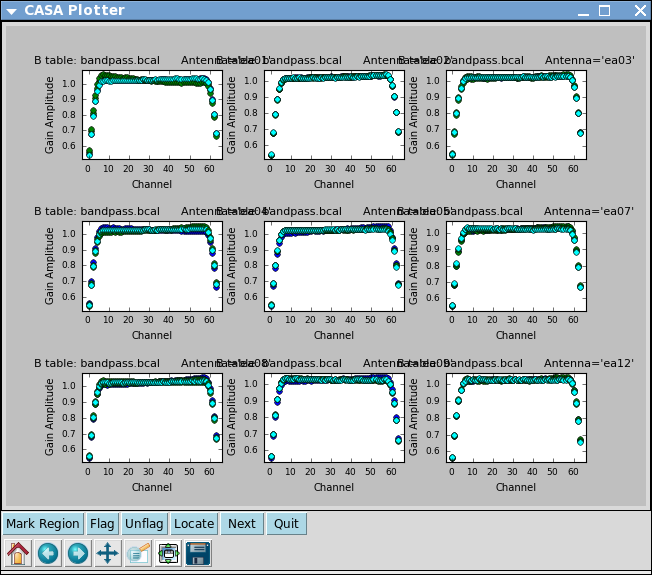
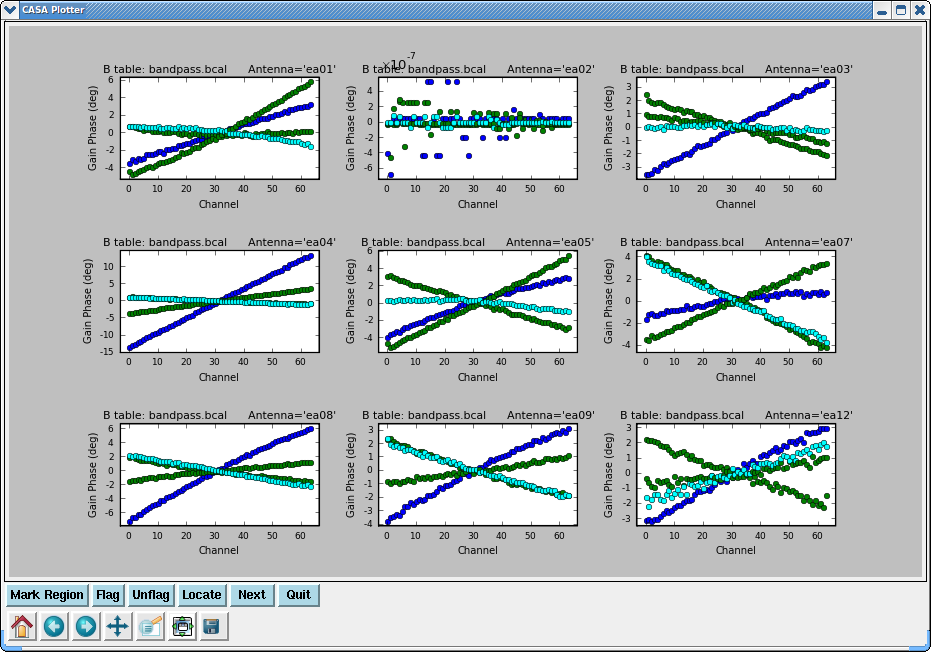
# In CASA
bandpass(vis='day2_TDEM0003_10s_norx',caltable='bandpass.bcal',field='5',
refant='ea02',solint='inf',solnorm=T,
gaintable=['bpphase.gcal'],spwmap=[[]],
opacity=0.03,gaincurve=T)
Plot the solutions, amplitude and phase
# In CASA
plotcal(caltable='bandpass.bcal',xaxis='chan',yaxis='amp',
iteration='antenna',subplot=331)
# In CASA
plotcal(caltable='bandpass.bcal',xaxis='chan',yaxis='phase',
iteration='antenna',subplot=331)
Note that phases on ea12 look noiser than other antennas. This jitter could indicate bad pointing -- note ea12 had just come back in the array.
This step isn't necessary from a calibration perspective, but if you want to go ahead and check the bandpass calibration on the bandpass calibrator you can run applycal here. In future we hope to plot corrected data on-the-fly without this applycal step. Later applycals will overwrite this one, so no need to worry.
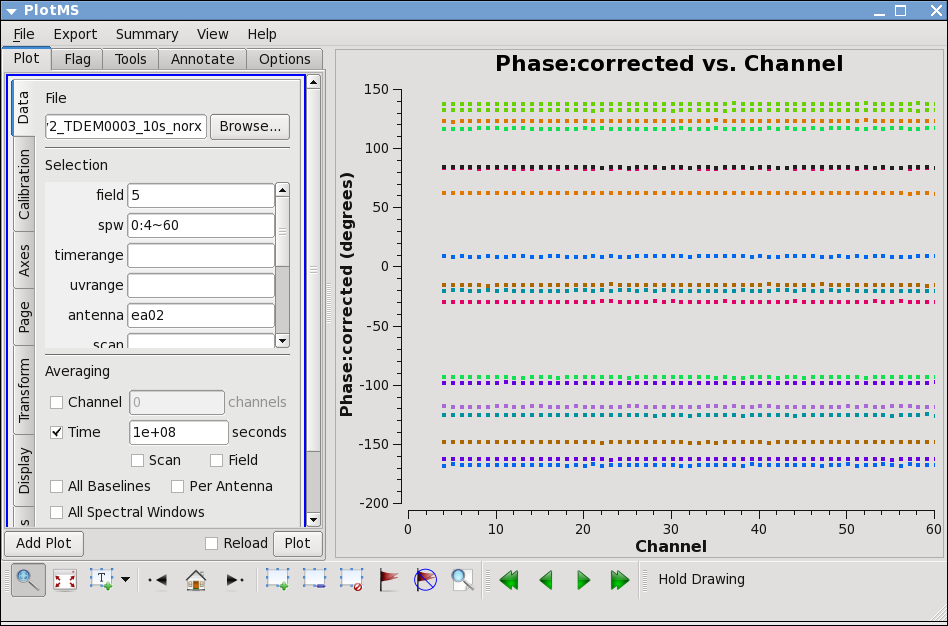
applycal(vis='day2_TDEM0003_10s_norx',field='5',
gaintable=['bandpass.bcal'],
spwmap=[[]],gainfield=['5'],
opacity=0.03,gaincurve=T)
plotms(vis='day2_TDEM0003_10s_norx',field='5',
xaxis='channel',yaxis='phase',ydatacolumn='corrected',
correlation='RR',
avgtime='1e8',spw='0:4~60',antenna='ea02')
plotms(vis='day2_TDEM0003_10s_norx',field='5',
xaxis='channel',yaxis='amp',ydatacolumn='corrected',
correlation='RR',
avgtime='1e8',spw='0:4~60',antenna='ea02')
Note that the phase and amplitude as a function of channel is very flat now.
Gain Calibration
Now that we have a bandpass solution to apply we can solve for the antenna-based phase and amplitude gain calibration. Since the phase changes on a much shorter timescale than the amplitude, we will solve for them separately. In particular, if the phase changes significantly over a scan time, the amplitude would be decorrelated, if the un-corrected phase were averaged over this timescale. Note that we re-solve for the gain solutions of the bandpass calibrator, so we can derive new solutions that are corrected for the bandpass shape. Since the bandpass calibrator will not be used again, this is not strictly necessary, but is useful to check its calibrated flux density for example.
# In CASA
gaincal(vis='day2_TDEM0003_10s_norx',caltable='intphase.gcal',
field='2,5,7',spw='0~1:4~60',
refant='ea02',calmode='p',solint='int',minsnr=2.0,
gaintable=['bandpass.bcal'],spwmap=[[]],
opacity=0.03,gaincurve=T)
Here solint='int' coupled with calmode='p' will derive a single phase solution for each 10 second itegration. Note that the bandpass table is applied on-the-fly before solving for the phase solutions, however the bandpass is NOT applied to the data permanently until applycal is run later on.
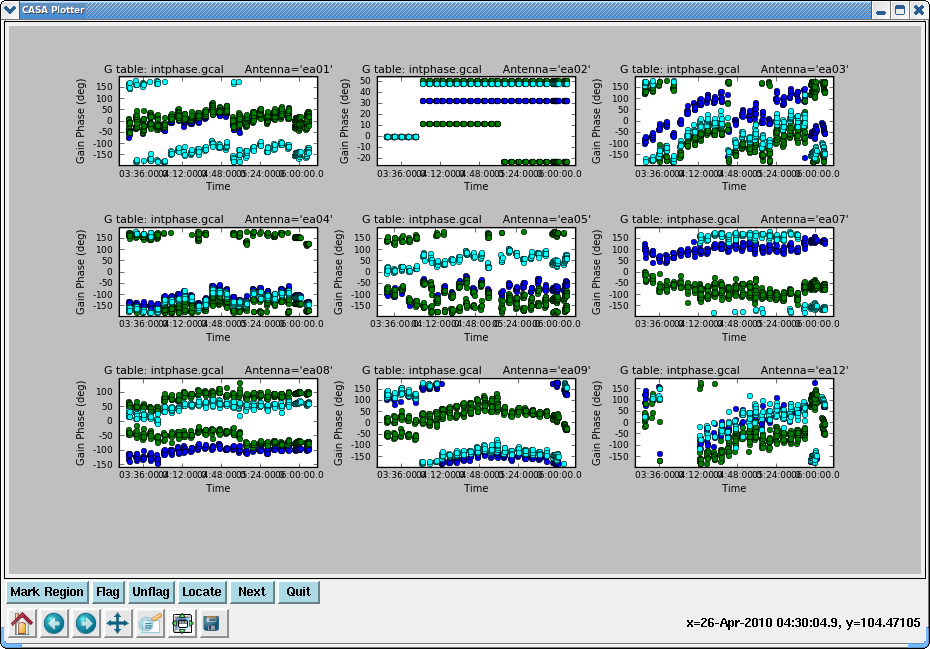
Now look at the phase solution, and note the obvious scatter within a scan time.
# In CASA
plotcal(caltable='intphase.gcal',xaxis='time',yaxis='phase',
iteration='antenna',subplot=331)
Although this 'int' solution is the best choice to use for solving for the amplitude solutions, it is not a good idea to use this to apply to the target. This is because the phase-scatter within a scan can dominate the interpolation between calibrator scans. Instead, we solve for the phase on the scan time, solint-'inf' (but combine=) for application to the target later on.
# In CASA
gaincal(vis='day2_TDEM0003_10s_norx',caltable='scanphase.gcal',
field='2,5,7',spw='0~1:4~60',
refant='ea02',calmode='p',solint='inf',minsnr=2.0,
gaintable=['bandpass.bcal'],spwmap=[[]],
opacity=0.03,gaincurve=T)

# In CASA
plotcal(caltable='scanphase.gcal',xaxis='time',yaxis='phase',
iteration='antenna',subplot=331)
Alternatively, one can also run smoothcal to smooth the solutions derived on the integration time.
Next we apply the bandpass and solint='int' phase-only calibration solutions on-the-fly to derive amplitude solutions. Here the use of solint='inf', but combine= will result in one solution per scan interval.
# In CASA
gaincal(vis='day2_TDEM0003_10s_norx',caltable='amp.gcal',
field='2,5,7',spw='0~1:4~60',
refant='ea02',calmode='ap',solint='inf',minsnr=2.0,
gaintable=['bandpass.bcal','intphase.gcal'],spwmap=[[],[]],
opacity=0.03,gaincurve=T)

Now lets look at the resulting phase solutions, since we have taken out the phase as best we can by applying the solint='int' phase-only solution this plot will give a good idea of the residual phase error. If you see scatter of more than a few degrees here, you should consider going back and looking for more data to flag, particularly bad timeranges etc.
# In CASA
plotcal(caltable='amp.gcal',xaxis='time',yaxis='phase',
iteration='antenna',subplot=331)
Indeed, both antenna ea12 (all times) and ea23 (first 1/3 of observation) show particularly large residual phase noise.
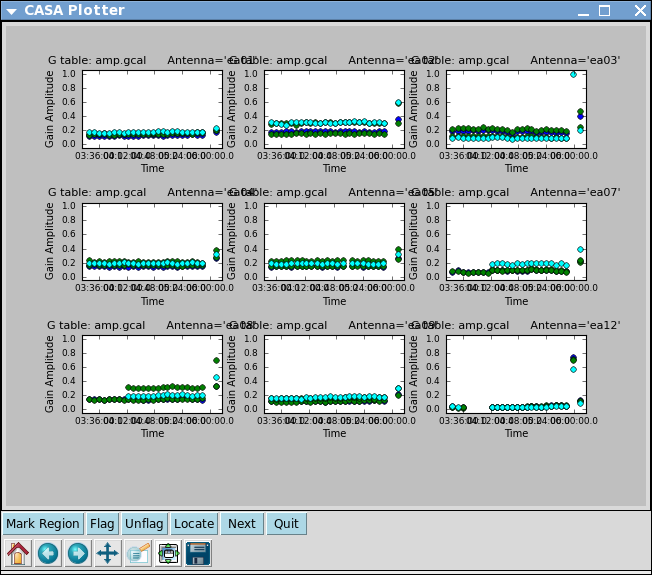
# In CASA
plotcal(caltable='amp.gcal',xaxis='time',yaxis='amp',
iteration='antenna',subplot=331)
Note that the amplitude solutions for ea12 are very low, this is another indication that this antenna is dubious.
Next we use the flux calibrator (whose flux density was set in the Setjy step above) to derive the flux of the other calibrators. Note that the flux table REPLACES the amp.gcal in terms of future application of the calibration to the data, i.e. the flux table contains both the amp.gcal and flux scaling, unlike the gain calibration steps, this is not an incremental table.
# In CASA
fluxscale(vis='day2_TDEM0003_10s_norx',caltable='amp.gcal',
fluxtable='flux.cal',reference='7')
It is a good idea to note down for your records the derived flux densities
Flux density for J0954+1743 in SpW=0# is: 0.267699 +/- 0.00103786 (SNR = 257.934, nAnt= 19) Flux density for J0954+1743 in SpW=1# is: 0.279468 +/- 0.000735923 (SNR = 379.752, nAnt= 19) Flux density for J1229+0203 in SpW=0# is: 30.5454 +/- 0 (SNR = inf, nAnt= 19) Flux density for J1229+0203 in SpW=1# is: 30.2306 +/- 0 (SNR = inf, nAnt= 19)
Check that the flux.cal table looks as expected.
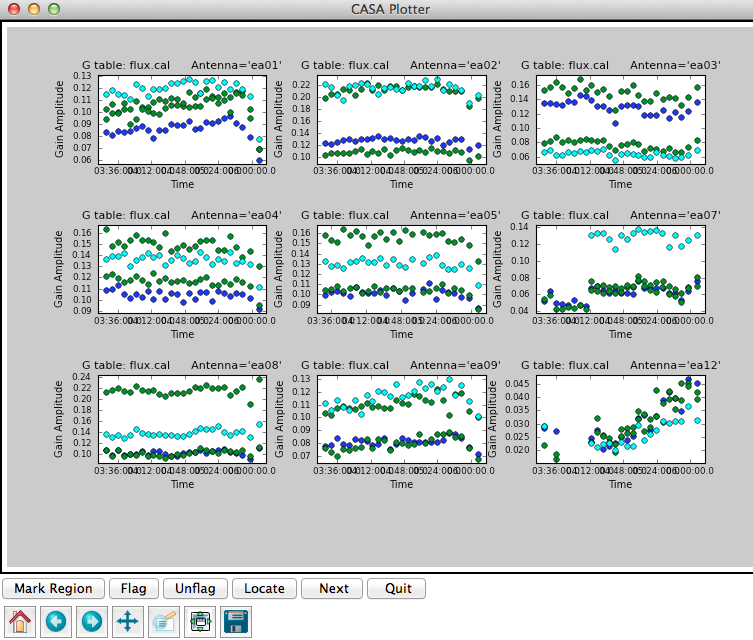
# In CASA
plotcal(caltable='flux.cal',xaxis='time',yaxis='amp',
iteration='antenna',subplot=331)
Applycal and Inspect
Now we apply the calibration to each source, according to which tables are appropriate, and which source should be used to do that particular calibration. For the calibrators, all bandpass solutions come from the bandpass calibrator (id=5), and the phase and amplitude calibration comes from themselves.
# In CASA
applycal(vis='day2_TDEM0003_10s_norx',field='2',
gaintable=['bandpass.bcal','intphase.gcal','flux.cal'],
spwmap=[[],[],[]],gainfield=['5','2','2'],
opacity=0.03,gaincurve=T)
# In CASA
applycal(vis='day2_TDEM0003_10s_norx',field='5',
gaintable=['bandpass.bcal','intphase.gcal','flux.cal'],
spwmap=[[],[],[]],gainfield=['5','5','5'],
opacity=0.03,gaincurve=T)
# In CASA
applycal(vis='day2_TDEM0003_10s_norx',field='7',
gaintable=['bandpass.bcal','intphase.gcal','flux.cal'],
spwmap=[[],[],[]],gainfield=['5','7','7'],
opacity=0.03,gaincurve=T)
For the target we apply the bandpass from id=5, and the calibration from the gain calibrator (id=2)
# In CASA
applycal(vis='day2_TDEM0003_10s_norx',field='3',
gaintable=['bandpass.bcal','scanphase.gcal','flux.cal'],
spwmap=[[],[],[]],gainfield=['5','2','2'],
opacity=0.03,gaincurve=T)
Now inspect the corrected data
# In CASA
plotms(vis='day2_TDEM0003_10s_norx',field='5',ydatacolumn='corrected',
xaxis='time',yaxis='amp',correlation='RR,LL',
avgchannel='64',spw='0:4~60',antenna='')
This source looks good
# In CASA
plotms(vis='day2_TDEM0003_10s_norx',field='2',ydatacolumn='corrected',
xaxis='time',yaxis='amp',correlation='RR,LL',
avgchannel='64',spw='0:4~60',antenna='')
Here we see some problems, with high points. Do some mark regions and locate in plotms to find out which antennas, which spws. Pay special attention to antennas that have been called out already as showing some dubious behavior.
What you find is that ea07 which we flagged spw=1 above, is also bad for the same timerange in spw=0. This was not obvious in the raw data, because spw=0 was adjusted in the on-line system by a gain attenuator, while spw=1 wasn't. So a lack of power on this antenna can look like very low (and obvious) amplitudes in spw=1 but not for spw=0. Looking carefully you'll see that ea07 is actually pretty noisy throughout.

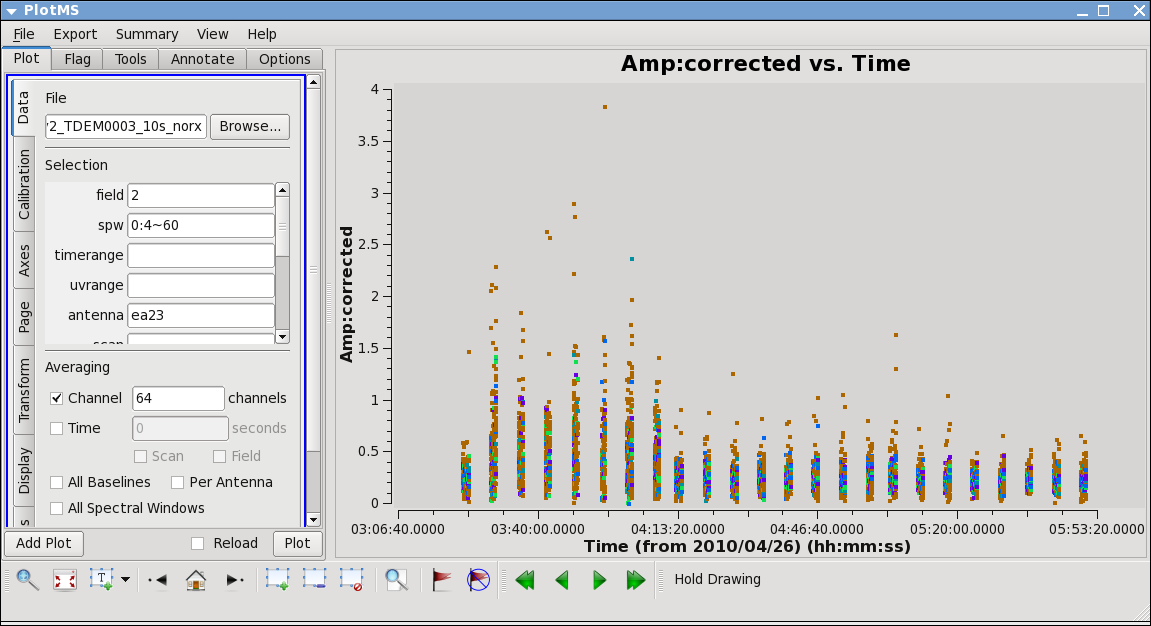
From the locate we also find that ea12 and ea23 show some high points, replot them alone
plotms(vis='day2_TDEM0003_10s_norx',field='2',ydatacolumn='corrected',
xaxis='time',yaxis='amp',correlation='RR,LL',
avgchannel='64',spw='0:4~60',antenna='ea12')
plotms(vis='day2_TDEM0003_10s_norx',field='2',ydatacolumn='corrected',
xaxis='time',yaxis='amp',correlation='RR,LL',
avgchannel='64',spw='0:4~60',antenna='ea23')
ea12 needs to be flagged completely its just a bit noisy all around and ea23 is pretty noisy during the first scans between initial and second pointing. Recall that these are antennas we became suspicious of while inspecting the calibration solutions.
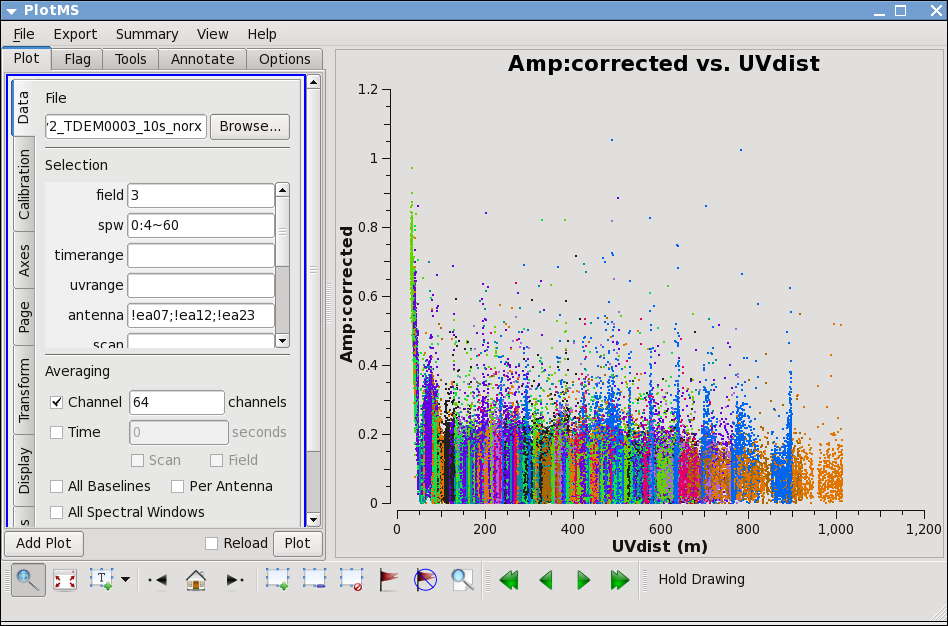
Now lets see how the target looks. Because the target has resolved structure, its best to look at it as a function of uvdistance. We'll go ahead and exclude the three antennas we already know have problems.
# In CASA
plotms(vis='day2_TDEM0003_10s_norx',field='3',ydatacolumn='corrected',
xaxis='uvdist',yaxis='amp',correlation='RR,LL',
avgchannel='64',spw='0:4~60',antenna='!ea07;!ea12;!ea23')
in "display" tab chose colorize by antenna2, here you will see that the spikes are caused by a single antenna. Use, zoom, mark, and locate to see which one. Also look at spw=1.
Turns out to be ea28, to confirm, replot with antenna=!ea28, and
# In CASA
plotms(vis='day2_TDEM0003_10s_norx',field='3',ydatacolumn='corrected',
xaxis='uvdist',yaxis='amp',correlation='RR,LL',
avgchannel='64',spw='0:4~60',antenna='!ea07;!ea12;!ea23;!ea28')
Its got issues until 2/3 through. Plot another distant antenna to compare. We will go ahead and flag it all, since its hanging far out on the north arm by itself.
Now the additional data we've identified as bad need to be flagged and then all the calibration steps run again.
# In CASA
flagdata(vis='day2_TDEM0003_10s_norx',
field=['',''],
spw=['',''],
antenna=['ea07,ea12,ea28','ea07,ea23'],
timerange=['','03:21:40~04:10:00'])
Redo Calibration after more Flagging
Below we repeat the calibration steps above, appending _redo to the table names, in case we want to compare with previous versions, its best not to remove and overwrite them.
# In CASA
gaincal(vis='day2_TDEM0003_10s_norx',caltable='bpphase_redo.gcal',
field='5',spw='0~1:20~40',
refant='ea02',calmode='p',solint='int',minsnr=2.0,
opacity=0.03,gaincurve=T)
# In CASA
bandpass(vis='day2_TDEM0003_10s_norx',caltable='bandpass_redo.bcal',
field='5',
refant='ea02',solint='inf',solnorm=T,
gaintable=['bpphase_redo.gcal'],spwmap=[[]],
opacity=0.03,gaincurve=T)
# In CASA
gaincal(vis='day2_TDEM0003_10s_norx',caltable='intphase_redo.gcal',
field='2,5,7',spw='0~1:4~60',
refant='ea02',calmode='p',solint='int',minsnr=2.0,
gaintable=['bandpass_redo.bcal'],spwmap=[[]],
opacity=0.03,gaincurve=T)
# In CASA
gaincal(vis='day2_TDEM0003_10s_norx',caltable='scanphase_redo.gcal',
field='2,5,7',spw='0~1:4~60',
refant='ea02',calmode='p',solint='inf',minsnr=2.0,
gaintable=['bandpass_redo.bcal'],spwmap=[[]],
opacity=0.03,gaincurve=T)
# In CASA
gaincal(vis='day2_TDEM0003_10s_norx',caltable='amp_redo.gcal',
field='2,5,7',spw='0~1:4~60',
refant='ea02',calmode='ap',solint='inf',minsnr=2.0,
gaintable=['bandpass_redo.bcal','intphase_redo.gcal'],
spwmap=[[],[]],
opacity=0.03,gaincurve=T)
# In CASA
fluxscale(vis='day2_TDEM0003_10s_norx',caltable='amp_redo.gcal',
fluxtable='flux_redo.cal',reference='7')
Flux density for J0954+1743 in SpW=0 is: 0.279304 +/- 0.00114727 (SNR = 243.452, nAnt= 16) Flux density for J0954+1743 in SpW=1 is: 0.287039 +/- 0.00107576 (SNR = 266.824, nAnt= 16) Flux density for J1229+0203 in SpW=0 is: 30.5932 +/- 0 (SNR = inf, nAnt= 16) Flux density for J1229+0203 in SpW=1 is: 30.2475 +/- 0 (SNR = inf, nAnt= 16)
Feel free to pause here and remake the calibration solution plots from above, just be sure to put in the revised table names.
Redo Applycal and Inspect
# In CASA
applycal(vis='day2_TDEM0003_10s_norx',field='2',
gaintable=['bandpass_redo.bcal','intphase_redo.gcal','flux_redo.cal'],
spwmap=[[],[],[]],gainfield=['5','2','2'],
opacity=0.03,gaincurve=T)
# In CASA
applycal(vis='day2_TDEM0003_10s_norx',field='5',
gaintable=['bandpass_redo.bcal','intphase_redo.gcal','flux_redo.cal'],
spwmap=[[],[],[]],gainfield=['5','5','5'],
opacity=0.03,gaincurve=T)
# In CASA
applycal(vis='day2_TDEM0003_10s_norx',field='7',
gaintable=['bandpass_redo.bcal','intphase_redo.gcal','flux_redo.cal'],
spwmap=[[],[],[]],gainfield=['5','7','7'],
opacity=0.03,gaincurve=T)
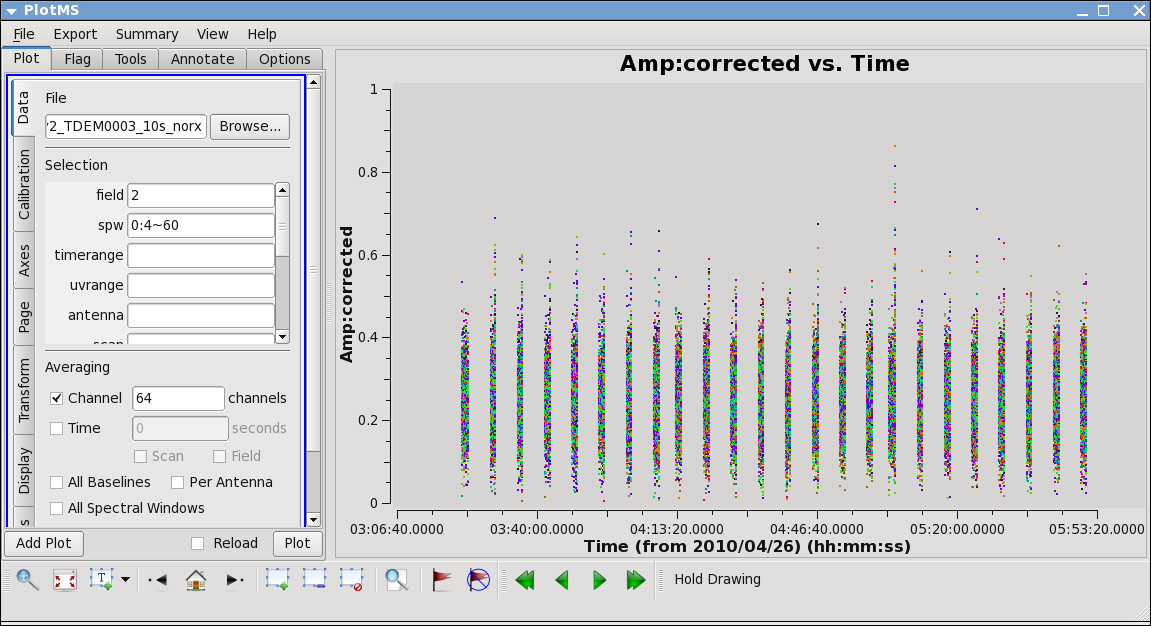
# In CASA
applycal(vis='day2_TDEM0003_10s_norx',field='3',
gaintable=['bandpass_redo.bcal','scanphase_redo.gcal','flux_redo.cal'],
spwmap=[[],[],[]],gainfield=['5','2','2'],
opacity=0.03,gaincurve=T)
Now you can inspect the calibrated data again. Except for random scatter things look pretty good.
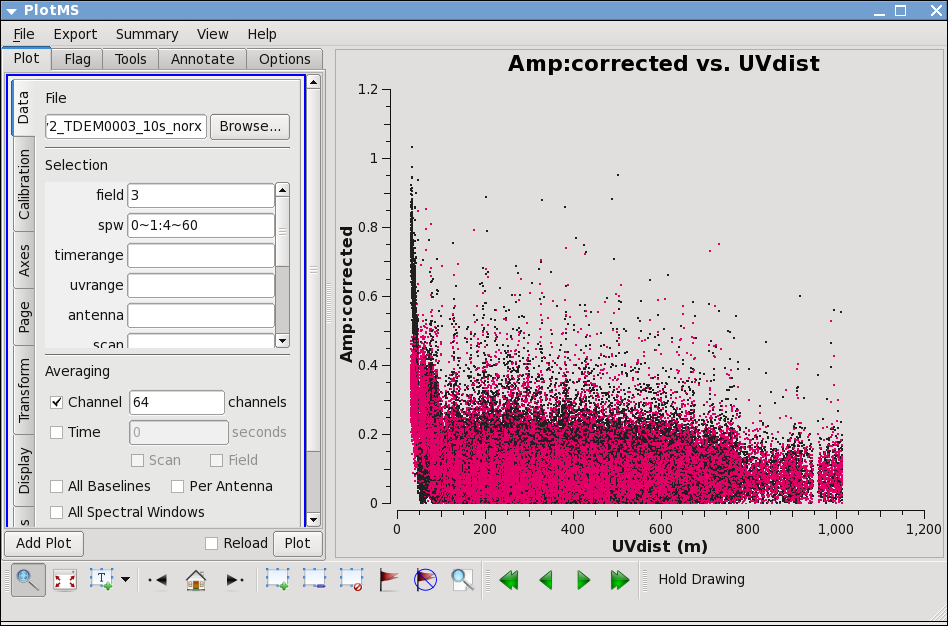
# In CASA
plotms(vis='day2_TDEM0003_10s_norx',field='2',ydatacolumn='corrected',
xaxis='time',yaxis='amp',correlation='RR,LL',
avgchannel='64',spw='0:4~60',antenna='')
Lets check the target again, looking at both spws, and selecting "Display" colorize by spw.
# In CASA
plotms(vis='day2_TDEM0003_10s_norx',field='3',ydatacolumn='corrected',
xaxis='uvdist',yaxis='amp',correlation='RR,LL',
avgchannel='64',spw='0~1:4~60',antenna='')
Split
Now we split the data into individual files. This is not strictly necessary, as you can select the appropriate fields in later clean stages, but it is safer in case for example you get confused with later processing and want to fall back to this point (this is especially a good idea if you plan to do continuum subtraction or self calibration later on). It also makes smaller individual files in case you want to copy to another machine, colleague what have you.
# In CASA
split(vis='day2_TDEM0003_10s_norx',outputvis='day2_J0954',
field='2')
# In CASA
split(vis='day2_TDEM0003_10s_norx',outputvis='day2_IRC10216',
field='3')
# In CASA
split(vis='day2_TDEM0003_10s_norx',outputvis='day2_3C286',
field='7')
Deconvolve and Clean
Here we make images from the calibrated data. Because the spectral line emission from IRC+10216 has significant extended emission, it is very important to run clean interactively, and make a clean mask. In this example, when the viewer first pops up with the dirty image, we step through to the channel with the most extended (in angular size) emission, select "all channels" for the clean mask, select the polygon tool and make a single mask that applies to all channels. After making the mask you should check that the emission in all the other channels fits within the mask you made. If you had the time and patience you could make a clean mask for each channel -- this would create a slightly better result.
Keep cleaning until the residual displayed in the view looks "noise like". You will notice that in this particular case, there are residuals that cannot be cleaned -- these are due to the extended resolved out structure on size scales larger than the array is sensitive to (i.e. "Largest Angular Scale" or LAS the array is sensitive to can be calculated from the shortest baseline length). Later in the tutorial we describe how to do a better job with extended sources.

# In CASA
clean(vis='day2_IRC10216',imagename='day2_IRC10216_HC3N.cube_r0.5',
imagermode='csclean',
imsize=300,cell=['0.4arcsec'],spw='0:5~58',
mode='velocity',interpolation='linear',
restfreq='36.39232GHz',outframe='LSRK',
weighting='briggs',robust=0.5,
mask='',
interactive=T,threshold='3.0mJy',niter=100000)
Repeat the process for the SiS line, note that the emission for this line is less extended than the HC3N -- this has to do with the different excitation requirements of the two different lines. The SiS is excited closer to the centeral star than the HC3N.
# In CASA
clean(vis='day2_IRC10216',imagename='day2_IRC10216_SiS.cube_r0.5',
imagermode='csclean',
imsize=300,cell=['0.4arcsec'],spw='1:5~58',
mode='velocity',interpolation='linear',
restfreq='36.30963GHz',outframe='LSRK',
weighting='briggs',robust=0.5,
mask='',
interactive=T,threshold='3.0mJy',niter=100000)
In the near future we will substitute with multiscale clean. This dramatically improves the cleaning, but a few tweaks are needed to CASA before its usable. Below is a one channel example.
